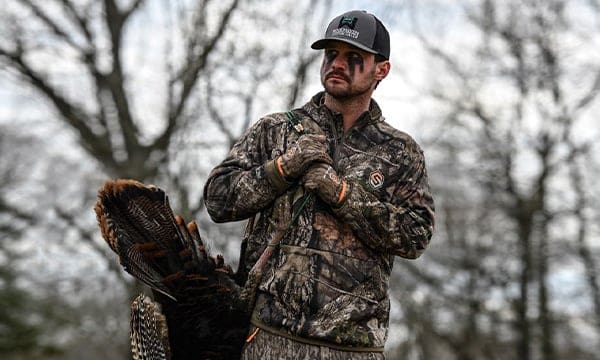Most turkey hunters have felt the sucker punch to the stomach when trying to call a spring gobbler into shooting range doesn’t go as planned. That gut-wrenching feeling typically occurs when a tom is gobbling his head off and coming to the call, only to have something happen that stops him from getting any closer.
Man and mother nature delivers many objects that can detour a hunt from going the way the hunter has planned. When these incidents happen, turkey hunters often want to throw their hands up and wait until another day. Instead, hunters need to shake it off and keep hunting with perseverance. Below are three obstacles that could end a turkey hunt, but why they shouldn’t.

Rain
One of the best times to find a fired-up gobbler who is eager to come to a call is moments after a rainstorm has ended. Spring rain is a common occurrence during the period of most turkey seasons across the country. When hunters check the weather forecast the night before the hunt or wake up to pouring rain, they quickly assume that the hunt is over for that day.
The tom has likely spent the entire rainstorm alone while the hens lay on their nest to protect their eggs. When the rain stops, he is ready for action and to gobble. Don’t let the rain keep damper the hunt.
During a light rain, using a ground blind in open field areas is another way to continue hunting instead of calling it quits until the next day. Turkeys often travel to open areas when it is raining because they have better eyesight than when in the timber, where everything is in motion during the rain. Set up a few decoys, get in a ground blind, and be patient. Even when raining, a hunter would be surprised at how many turkeys can be lured into the shooting range.
Fences
One obstacle that can hold up a turkey from coming the remainder of the way into the shooting range is a fence. A woven wire fence can be a nightmare for a hunter trying to call a gobbler into close range. For some reason, turkeys do not like to cross a fence when responding to a call.
When a woven wire fence is between the turkey and the hunter, the turkey will stall while remaining to gobble. The tom will keep gobbling, hoping that the hen will come to him instead. After a period, when the hen does not come closer, the gobbler will lose interest and leave.
In order to prevent a woven fence from ruining the hunt, it is vital to scout the hunting area before the actual hunt. Knowing where all obstacles are located beforehand is vital.
Don’t give up if a gobbler hangs up on the opposite side of a fence when trying to call. A hunter should stop calling until the gobbler moves on in another direction. Once the gobbler has moved on, back out of the area, get in a better position, and try again. A hen doesn’t like to cross a fence any more than a gobbler does. Ending the calling and backing out to get a better position mimics a real hen traveling until she comes to the surroundings she favors. Once the setup is improved, continue calling and try again.

Real Hens
One of the biggest obstacles that turkey hunters face each spring is competing against other hens. When a tom is gobbling and committed to a hunter calling, it is common for a hen to try to steal the show. Especially when a tom is out of eyesight, the presence of another hen can cause the tom to go silent or detour in another direction.
When a tom has a hen with him, he often doesn’t respond to a call. The tom has found what he is looking for; there is no need for him to continue his search. When other hens are preventing a tom from responding to calls, there are two techniques I choose to use that often break the tom away from the hen or bring them both in closer to observe.
When a competitive hen interferes with my calling efforts, I change my focus to the hen. The hen often begins making sounds to keep the tom close to her. While the hen makes her sounds, I like to mimic her and exasperate her dominance. When the hen becomes curious to see who is challenging her, she responds by coming close to the call, often bringing the gobbler close behind.
The second tactic is to make the gobbler jealous by using a gobbler shaker call that reproduces the sound of a gobble. The hunter can emulate another gobbler who is coming to the calling. When the tom hears another gobbler responding to the call, he becomes jealous and will break away from the hen to come to see who has invaded his territory. The key is to use the gobbler shaker one or two times, only enough for the henned-up gobbler to hear the presence of another gobbler. Stay quiet and make the gobbler with the other hens curious, and he will respond.

To access a bigger advantage this turkey season, check out our apparel best fit for the occasion here.

